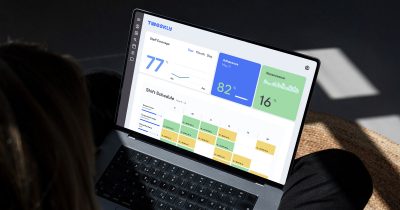

Top-4 Ecommerce Success KPIs That Are Critical to Growing Your Online Store
 21.02.2019 08:05
21.02.2019 08:05When tracking online sales in ecommerce, it’s easy to get caught up in vanity metrics, metrics that don’t really tell you much about how your online sales are performing.
From: wordstream.com
Impressions, clicks, and those other shiny looking metrics might look amazing on your Google Analytics reports, but they ultimately give you zero depth into what the heck is actually happening.
It’s amazing to open Analytics or your store stats and see 10,000 unique visitors today!
But did they buy from you? How much did it cost for you to get that site visit? And how many times does the average visitor engage with you before deciding to give you money?
You see, most metrics are very misleading. They sell you false hope of success.
When it comes down to it, only a few metrics matter for ecommerce success.
Ready to find out which?
1. Cost per acquisition AND lifetime value
Let’s start with the top dogs of ecommerce KPIs: cost per acquisition and lifetime value.
Why are they the top dogs? Because they determine just about every marketing and selling action you take.
Let me explain. First, let’s start with acquisition costs. Acquiring customers costs money, unfortunately. Whether you are getting them through content marketing, social media lead magnets, pay-per-click advertising, on Snapchat or even by sponsoring a new podcast, everything you do costs money.
While PPC is a more direct way of paying for traffic via clicks…

…you still incur costs when creating posts for social media or detailed content marketing pieces to attract organic visits.
For instance, the best blog posts for content marketing take at least six hours. And if you want to stand out today, sub-par content won’t cut it on SERPs.

And that’s just for a 1,151-word blog post:

Data shows that 2,000-word blog posts rank best. This mean that you’ll be paying for 12 hours or more of labor for a single piece of high-quality content. And labor ain’t cheap when you are hiring top quality writers.
All of this requires labor, design, and development that, unfortunately, you have to factor those into your acquisition costs.
Simply put, cost per acquisition is the average amount of money your ecommerce store has to spend to acquire a single customer.
Cost per acquisition is vitally important, as it can dramatically impact your acquisition strategy.
But, to get the full picture, you need to look at lifetime value too.
Customer lifetime value is the average amount of money a single customer will spend with you over their lifetime / relationship with your store.
The connection here is important, as analyzing either of these metrics alone won’t make sense.
Why? Here is an example:
Let’s say your cost per acquisition is $50. That’s fifty bucks for a single customer to do business with you.
So what? Alone, that doesn’t tell you much.
Now, let’s say your lifetime value is $45.
Only now can you make sense of these metrics. From the example above, your acquisition costs are too high, because they surpass the amount the customer spends with you!
But if your lifetime value is $500, a $50 cost per acquisition is nothing!
When analyzing key metrics for success, you should always start from the top with lifetime value and customer acquisition costs.
Depending on these KPIs, you can easily plan the next steps you need to take:
If your CPA is higher than your lifetime value: You are paying more to land the customer than they spend with you. This means you are not producing a profit. To combat this, you have a few options. You can cut costs on advertising or find ways to produce cheaper lead magnets and content marketing. Or you can focus on improving your customer retention and focus on upselling existing and loyal customers to build lifetime value. Building lifetime value per customer will help you afford those acquisition costs.
If your lifetime value is higher than your CPA: Congrats! You are doing great. This opens the door for tons of growth. If LTV is far higher than CPA, you are making a profit per customer and have room to spend even more on customer acquisition because of your high lifetime values. LTV can be higher for ecommerce subscription businesses or companies selling online courses and digital subscriptions, as monthly recurring revenue can greatly increase LTV. With a return on ad spend (ROAS) over 3:1, you can focus heavily on new customer acquisition and sustainable growth.
2. Cart abandonment rate
Cart abandonment rate is the percentage of people who leave their cart after putting items into it on your store.
This pesky little metric can tell you a lot about your current ecommerce store and website. Cart abandonment tells you if your website is killing it or driving people away in masses. It’s one of the most annoying metrics to see on your dashboard, but it’s also one of the most telling, helpful metrics to analyze.
According to Statista data, cart abandonment averages at 74.2% for online retailers in 2018.
That’s high. Too high.
While not all stores will have such a high rate, the average ecommerce store does. What are the most common reasons? Almost all of them have to do with key purchasing pain points:
- Expensive shipping
- No free shipping
- Unaware of shipping costs
- Slow shipping
- Researching
- Long process
- Bad site UI
Thanks to Amazon, shipping has become a value point in its own right. No longer are the days where people will patiently wait 7-10 business days to receive the product they ordered. Not when Amazon delivers in two days (or even same-day).
Do you have competitors selling on Amazon with similar products and pricing to you? Do you have high cart abandonment rates?
You can bet that people are abandoning your cart, looking to Amazon, finding competitors, and getting their products because of shipping.
So, how can you combat it?
By tackling cart abandonment rates at the source:
- Showcase pain points during the cart process
- Improve speed
First, you need to combat pain points during the checkout process. And the biggest pain points all revolve around shipping:
- Cost
- Time to ship
- Estimated delivery dates
Amazon wins the shipping game not just because they have two-day shipping, but also because they are so clear about your shipping expectations before you even order the product:

People know exactly when they are going to get their product instead of seeing “7-10 business days after order processing.” What does that even mean for a consumer? How are they supposed to know what your order processing looks like? Is that one day? Next week?
These all cause frustration and lead to cart abandonment rates. On your checkout page, be sure to make shipping as clear as Amazon does.
Another key reason for cart abandonment is bad user experience. How fast is your site? Is it easy to navigate? Choose a top web hosting provider with uptime history monitoring that won’t impact your site speed. Google data shows that most websites are far too slow:

This can lead to big bounce rates and cart abandonment:

Are you making customers wait seconds between each step of the checkout process due to speed? They aren’t gonna stick around. Data shows that most people use WordPress to create a website.

In addition to WordPress ecommerce plugins, there are countless plugins that you can use with WordPress to increase speed.

Simplify your checkout process, improve your speed, and address shipping pain points right in the checkout process with detailed information. This will result in much lower cart abandonment and improved sales.
3. Branded online search impressions
I know what you’re thinking: Didn’t he just say that vanity metrics are worthless?
You bet I did.
But online search impressions aren’t a vanity metric when you are concerned with brand awareness. For most ecommerce stores during the growth phase, this is a vanity metric. But once you have a steady stream of organic sales, it’s anything but a vanity metric.
You see, most new commerce stores make the mistake of focusing on this too early. This leads them to have distorted views of what metrics matter. Only when you have consistent organic sales should you start monitoring your branded online search impressions.
When it comes to ecommerce marketing, you need to look at it with a funnel just like any business:

Depending on funnel stages, KPIs can change.
When it comes to developing a growth strategy with key metrics, you have to start at the top, listing metrics that you can track years in advance and ones that also matter more in the short-term development of your store, like brand awareness:

Branded online search impressions is a metric that tells you how many people are organically (not paid) searching for your brand on different channels.
An easy way to track online branded search impressions is via a keyword tool, either directly on Google Ads or through a tool like WordStream, Moz, SEMRush. orAhrefs.
For instance, if I wanted to track the branded online search impressions for WordStream, I would plug variations of “WordStream” into the keyword tool to see how many monthly search impressions are:

Then, you can track impressions over time, as they hopefully increasing month over month.
Organic branded search impressions tell you how well your marketing efforts are paying off for building brand awareness, even in local markets.
If more people are starting to search for your store via branded searches, you are doing something right!
Another great way to manage online impression building is via customer reviews. This can help you learn about customer complaints, trends of how your reviews look, and where you can improve:

Plus, it’s far easier to sell to brand aware searchers than people who have never heard of you before!
4. Average order value
The average order value, or AOV, is a metric that shows you how big an average order on your website is.
This is the average figure for all the orders made on your website during a particular period of time. This number tells you how many people really want to buy from you and in what quantity.
In simple terms, AOV is total revenue divided by the number of orders you have:

AOV can tell you a ton about your current selling strategy.
It’s one thing to have 1,000 new orders on your store for $5 each compared to 500 orders for $100. The revenue differences are huge. Most people will get caught up in having more orders. More unique orders from new customers. But more often than not, the fastest way to increase total revenue isn’t to acquire more customers.
Why?
You are paying to acquire more customers, and they aren’t going to be your biggest spenders.
It’s often repeat purchasers who spend the most with a business. In this case, you don’t need more and more orders. You just need bigger average order values! That is why, as an ecommerce owner or digital marketing expert, you should be aiming at maximizing the AOV before total order volume.
The other interesting thing about the AOV is that knowing this number will help you easily define the threshold for free shipping. You can even use this is a tactic to increase average order values over time!
For instance, this is a strategy that Pura Vida Bracelets takes to increase their AOV and meet the shipping preferences of their consumers:

“Free Shipping On All Orders $30+”
Using the strategy, they can drive AOVs above $30 and provide shipping value. This way, they don’t need thousands of orders for $5. They need far less but with higher order values per sale. AOV is a useful metric for tracking how well you are selling to new, existing, and loyal customers.
Conclusion
Ecommerce metrics are almost limitless. But KPIs like CPA, AOV, branded search impressions, CLTV, and cart abandonment are some of the most important ones around.
If your reporting is focused on vanity metrics like clicks and impressions, it’s time to shift your perspective. While those vanity metrics can be great for measuring brand awareness, they aren’t so good for measuring direct revenue gains. And getting too caught up in the glitz and glamour of them will have you draining your company account faster than you can blink.
Focus your ecommerce data strategy on the metrics we covered today and you will be a better leader in the space and set yourself up for success in the future.
Read more –
Read also

Mobile-First Award 2025: Public voting for the best mobile apps in Ukraine is now open


From Job Titles to Roles: Tweekly Provides a Skill Management Tool for Modern Teams


Mobile-first Award 2025: Ukraine’s First Mobile App Award










